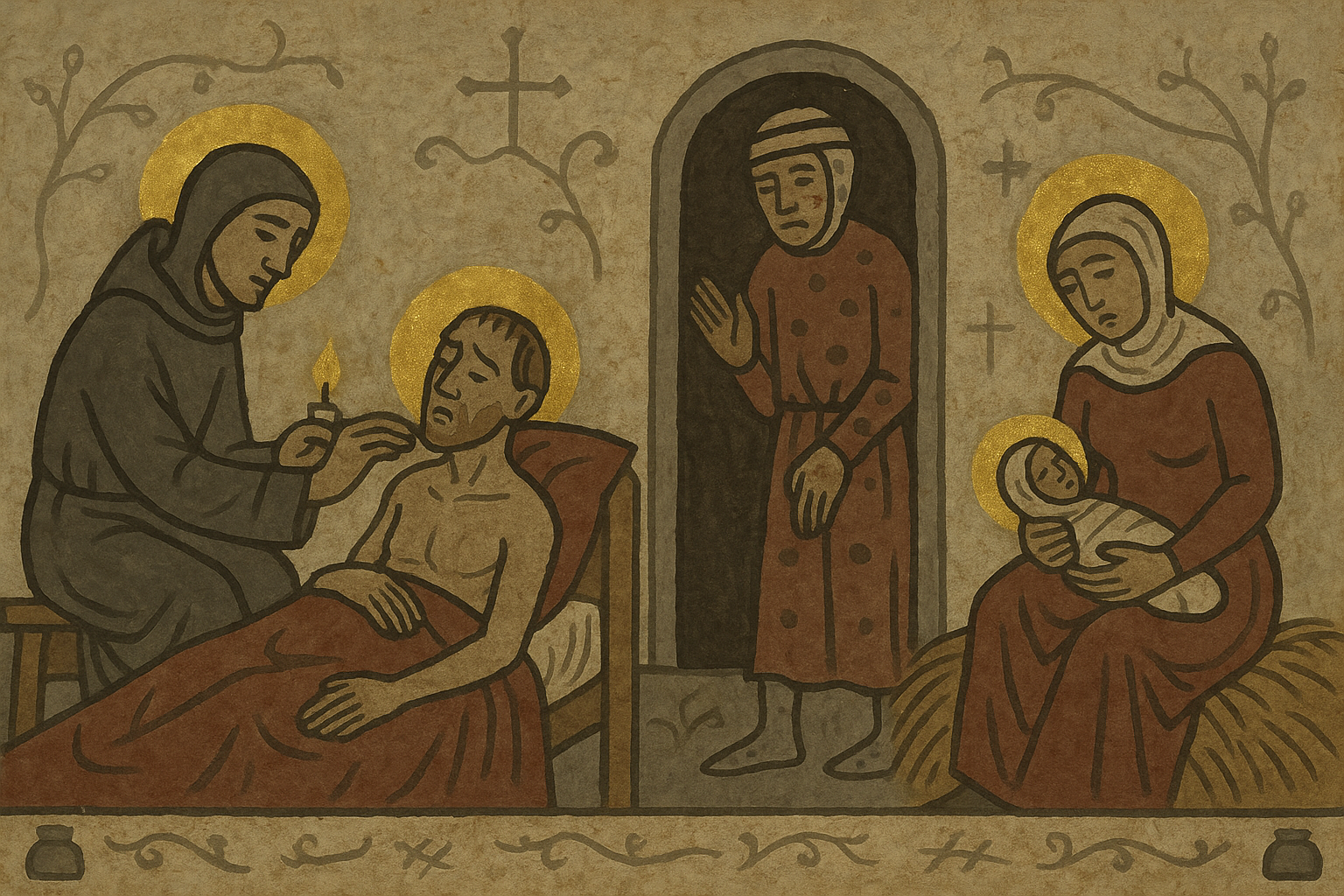
Medieval Europe often strikes modern readers as grotesque in its bodily realities. Chronicles tell of leper colonies at the city gates, lice in monks’ cowls, childbirth beside dung heaps, wounds dripping pus under linen bandages. The smells, the sores, the constant frailty of flesh appear to us as proof of how “unenlightened” those centuries were. And yet, within this same world, a deep sacramental imagination flourished—an understanding that grace did not bypass the body but worked through it, sometimes precisely through its decay.
To grasp medieval Christianity, and to write it with honesty in fiction, we must hold together two truths: the body was filthy, and the body was holy.
Illness as Liturgy
For medieval Christians, illness was not merely a biological misfortune. It was a liturgical moment. When a monk coughed blood in the cloister, or when a widow lay shivering with fever, their suffering was folded into the cosmic drama of salvation. The Church’s sacraments were not abstract rituals; they were interventions in frail flesh. The anointing of the sick was not symbolic alone—it was a literal consecration of sores, ulcers, failing joints. The Eucharist fed mouths that often had little else to eat.
In this imagination, sickness became a participation in Christ’s passion. A bleeding sore looked like His wounds. A wasting fever made Him feel the same way He did on the cross. Not every Christian handled these problems with calmness. There were complaints, groans, and desperate prayers all around. But the framework helped regular people see their pain as more than just random cruelty. It was a part of the story of redemption.
The Sanctity of Decay
One of the most striking features of medieval piety was its fascination with the corrupting body. Relics of saints would often include bones flecked with rot, hair preserved in wax, even whole cadavers that exuded strange scents. To touch such remains was not to recoil but to encounter sanctity. Death did not erase holiness; it made it tangible.
Hagiographies record saints who embraced lepers, kissed their sores, or even drank from their pus-filled wounds—acts that strike us today as obscene but were intended as radical imitations of Christ’s self-emptying love. These stories reveal a culture where filth was not outside the orbit of grace but could, in the right light, become its very vessel.
Frailty as Memory
Bodily weakness also functioned as memory. A limp from an old battle wound recalled both sin and survival. A woman’s scar from childbirth tied her to the ongoing rhythm of creation. Even lice and fleas—ever-present companions—were sometimes interpreted as humbling reminders of Adam’s fall. Frailty was not an interruption to life; it was life’s texture.
This is why medieval sermons and treatises so often drew theological lessons from the body. The skin was a parchment; wounds were Christ’s writing upon it. Tears were both salt of grief and water of baptism. Sweat, pus, and blood could all be made sacramental through the lens of imagination.
Filth as Mirror of Grace
The medieval view does not romanticize suffering. People still feared plague, cursed their toothaches, dreaded childbirth. But they lived with a conviction that grace was not antiseptic. God’s presence was not locked in sanitized chapels. It was found in barns, in battlefields, in sickbeds. Filth did not repel the divine—it exposed the very ground where God stooped to meet humanity.
This is the theology of the Incarnation taken seriously. If Christ took on flesh, He also took on its frailty: its sweat, its hunger, its open wounds. To imagine a spotless human existence was, in their minds, to deny the gospel itself. Grace did not erase filth; it transfigured it.
What Writers Can Learn
For historical fiction, this imagination is crucial. Too often we render medieval bodies as grotesque caricatures—rotting teeth, foul smells, sores described for shock value. That may capture realism, but without the sacramental lens it misses truth. The medieval mind saw grace shimmering in those very blemishes.
To write a fevered knight is not just to show delirium but to suggest how his companions might interpret his sweat as a share in Christ’s agony. To portray a peasant woman giving birth in straw is not just to show hardship but to suggest the sacred echoes of Mary in every labor. Filth without grace is exploitation; grace without filth is fantasy. It is their collision that creates authenticity.
Our world still struggles with the meaning of frailty. We hide illness in sterile hospitals, mask the smell of decay, sanitize death until it becomes almost invisible. And yet, like our ancestors, we remain creatures of flesh. Our sickness, our aging, our mortality still demand interpretation.
The medieval sacramental imagination offers us an alternative to denial. It insists that grace is not found by fleeing from the body but by passing through it. To see Christ in sores and scars is uncomfortable—but it is precisely there that the Incarnation refuses to be reduced to metaphor.
Closing Reflection
Filth and grace were not opposites in the medieval mind. They were two halves of the same revelation. The body’s weakness did not contradict sanctity—it revealed it. To write or to live with that conviction is to remember that holiness is not sterile, but incarnate.
In the end, the smell of sweat in a sickroom, the sting of pus in a wound, the ache of hunger in an empty belly—these are not intrusions on the sacred. They are its language. The God who bled is the God who sanctifies our frailty. And in that frailty, grace does not merely survive. It shines.